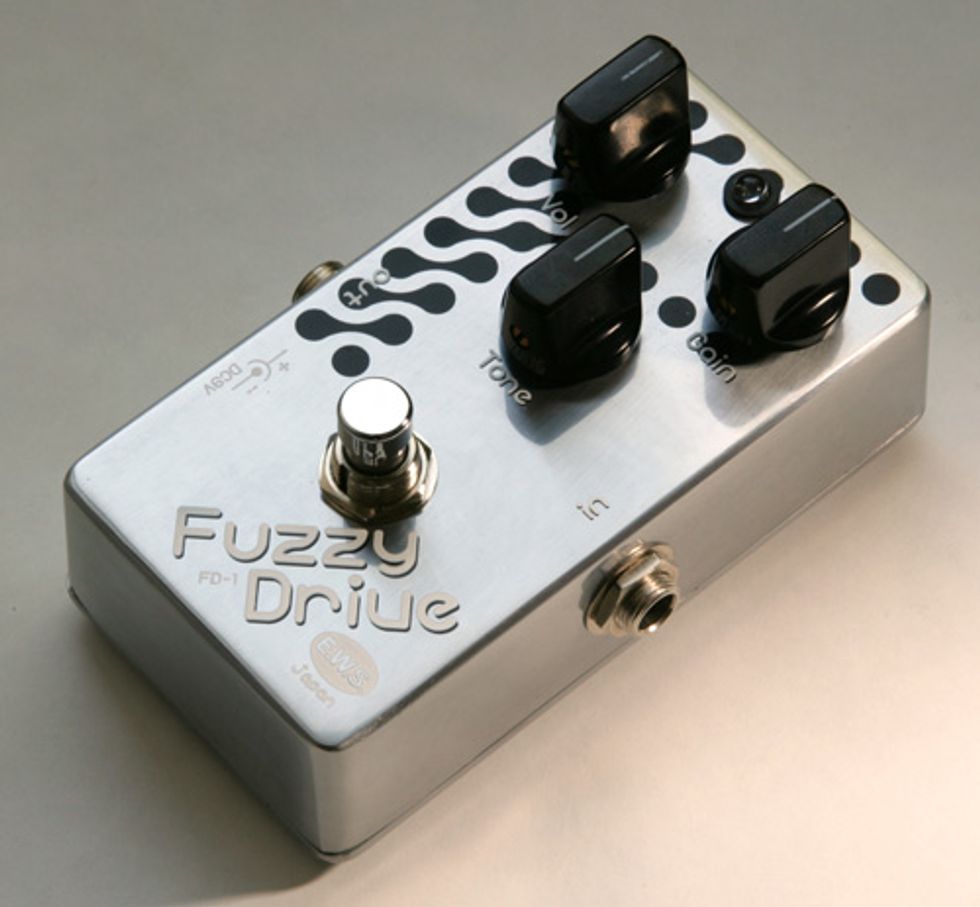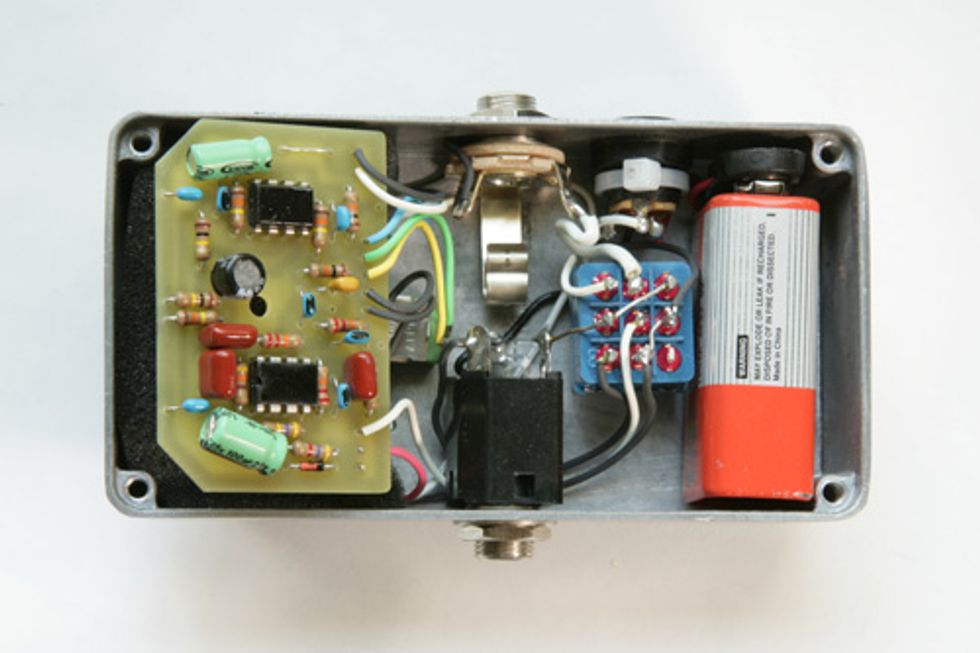 | |
| Download Example 1 | |
The FD-1 Fuzzy Drive is the first pedal produced by EWS (which stands for Engineering Work Store). The EWS name is not well known in the U.S., but has a fairly large following in Japan, where they specialize in guitar repairs and pedal modifications, their most well known being the Arion Chorus modification. Besides its foray into effect pedals, EWS is also introducing a line of tube-powered micro amps for the Japanese market. Like Xotic, EWS has a boutique aura about its products and service—at least in Japan where they are better known.
When you think of fuzz boxes, the first thing that comes to my mind is the theme song for Green Acres, or perhaps the Rolling Stones classic, “Satisfaction.” These early fuzz boxes had a raspy, edgy sound that, for a lot of guys, is a take-it-or-leave-it tone proposition. I'm not making this point to judge good or bad tone, but simply acknowledging that there is a pretty narrow interpretation of traditional fuzz box tones that one would rightfully expect out of something with the word “fuzz” in its name. So imagine my surprise when I plugged into the EWS Fuzzy Drive and got a range of tones from warm overdrive, to almost buzz saw. I was expecting a one-trick pony like an Electro-Harmonix Big Muff Pi or an Arbiter Fuzz Face, but found that the EWS Fuzzy Drive is a whole lot more.
With its three knobs, the FD-1 is deceptively simple. The Gain knob on the upper right determines how hard the incoming signal gets clipped; as this dial is turned clockwise, the more “fuzz” you’ll get. Up to about half way (straight up), the overall sound is like a tube amp breaking up. The sound is warm, and invites dynamic picking. At modest settings, soft strumming and light picking—even with the guitar’s volume up all the way—keeps the signal just under the clip threshold. Pick aggressively, and it goes right into sweet overdrive. Put the Gain knob at 5 o’clock (all the way up), however, and you’re almost into Green Acres territory—only the sound is creamier.
While the Gain control on the FD-1 controls the overall character, the Tone control gives it “edge.” To the extent that the purpose of a fuzz box is to clip the signal to the point that it effectively becomes a square wave, this introduces lots of high, jagged harmonics. The Tone control burnishes this nicely, and can leave all the buzziness in tact, or smooth it out almost entirely for a pure, synth-like tone. There’s plenty of range, and I found myself keeping it between halfway, and maxed out most of the time.
The last knob in the signal chain is the Volume dial, which determines how much signal the front of the amp sees. It was fun to experiment with how hard to hit the amp—which in this case was a Line 6 Spider Valve 112 tube amp. This amp is a hybrid that combines on-board digital effects and amp models with a classic tube power amp, but for this evaluation, we ran the amp on the cleanest setting. What we found was that even with no help from the on-board amp models, the EWS Fuzzy Drive had enough balls to hit the preamp really hard. With just a modest amount of gain on the FD-1, and a moderate dose of the volume knob (2 o’clock), the Line 6’s tubes were in a really happy place.
Physically, the FD-1 is a solid, tank-like piece of equipment. The cast aluminum box is brushed, then clear coated; a black retro-style graphic and white lettering is silk-screened on the box. Three black Bakelite knobs are solidly attached to the pots with brass set screws. Power comes from an on-board 9-volt battery, or external adapter. Since the FD-1 has a true bypass switch, when it’s turned off, there is no battery drain or output variance due to battery strength. We did notice, however, that at higher stage volumes, there was a noticeable click from the switch when the unit is turned on.
Inside, a simple circuit board carries 14 resistors, 13 capacitors, one diode, and one each of a dual op-amp and a single op-amp. The board is well protected by a foam cushion sandwiched between the board and the three potentiometers. Unlike classic fuzz boxes, no discrete transistors are used, which may be a deal breaker for some. (If you’re looking for germanium transistors, you’ll need to buy an antique, since mass-produced germanium-equipped fuzz boxes aren’t made any more.)

The pots themselves have a nice damped, quality feel to their movement, and you get the impression that this is a sturdy piece of gear that’s going to handle the road nicely. The Tone control also features a slight detent in the middle.
Although the FD-1’s claim to fame is as a fuzz box, using it only for only that is a little like saying that Angelina Jolie does a good job of playing Lara Croft. The fact of the matter is that the FD-1 is more like a distortion toolbox, capable of the full range of overdrive tones, from a slight break-up, to total metal mayhem. Truthfully, at many settings, it’s more “drive” than “fuzz,” and that’s what pushes it over the top for this reviewer. In a world where I could have only one box to do a whole range of overdrive sounds, I would really have to seriously consider the EWS Fuzzy Drive FD-1.
Ironically, the weakest point in the Fuzzy Drive’s repertoire is the classic mid-’60s buzz tone that can only come from discrete germanium transistors. We’re talking about the cheesiest tones in the speaker-slit-by-a-razor-blade category. Try as we might, we could not coax an ice-pick buzz-saw sound out of the FD-1. It came close, but always maintained a decidedly warm nuance. That’s just as well, because that’s a sound this reviewer would never try to find unless paid to.
The EWS box offers a lot of versatility, good build quality, and a boutique tone. Yet with a suggested retail price of $149, it’s squarely in average Joe territory. It’s interesting to note that sister company, Xotic, offers no fuzz pedals, so by entering the market first with the Fuzzy Drive, EWS is carving out a nice niche for itself that has little risk of impacting Xotic sales. We imagine some guys will be searching for a classic Tone Bender sound, and will try out the Fuzzy Drive, only to find that it’s more flexible, and a whole lot warmer. If it hits them like it hit us, the FD-1 will surely stoke the fires of creativity. We can’t wait to see what EWS comes out with next.
Buy if...
you're looking for a distortion toolbox that will kick your creativity with overdrive.
Skip if...
you're the guy they hired to create the soundtrack for Green Acres, the movie. Only an old Vox Tone Bender will do.
Rating...
MSRP $149 - EWS - ews-us.com |













![Rig Rundown: Russian Circles’ Mike Sullivan [2025]](https://www.premierguitar.com/media-library/youtube.jpg?id=62303631&width=1245&height=700&quality=70&coordinates=0%2C0%2C0%2C0)









